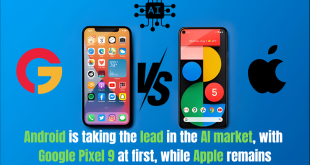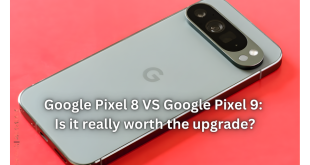Google Pixel 9 series released on August 22. Google has always been ahead because of its fluent stock Android software and its integration into the hardware for seamless processing. That’s what Google Pixel is known for. From a hardware point of view, Pixel phones have gotten little attention in recent years.
The whole Google Pixel 9 series uses the new Google Tensor G4 processor. The phone has 12GB of RAM and 128GB/256GB of storage, and the Pro series has 128GB (9 Pro)/256GB (9 Pro, 9 Pro XL)/512GB (9 Pro XL) of storage space.
As for other hardware configurations, in the competitive smartphone market of mid-range phones, they could not stand out in the range.
Their stock Android was a benchmark in the past for other phones with tons of bloatware like Samsung, but now the times have changed. By introducing AI integration into phones for better user compatibility, people have been going forward with AI.
Under the pixel ideology of “stable,” the market does not care much about the hardware strength of mobile phones. However, this product concept of “stable” encountered problems in the Pixel 9 series. Let’s discuss this further.
Before the product was released, some media complained about performing the Google Tensor G4 processor in Google Pixel 9 series. According to the feedback from bloggers who received the phone in advance, performing the Tensor G4 processor can be said to be “poor.” For example, in DameTech’s test, the average frame rate of the Pixel 9 Pro XL in the 720P resolution of the original is not only far behind the Galaxy S24 Ultra and iPhone 15 Pro Max using Snapdragon 8 Gen3, but even worse than the Pixel 7 Pro using the Tensor G2 processor two years ago, which is a reverse optimization.

Besides game tests, many bloggers’ performance benchmark tests revealed the same result. This “besieged on all sides” situation can’t help but remind people of the Pixel 8 series a year ago – the Tensor G3 used in the Pixel 8 series also had severe performance problems. Google’s ultimate solution was to “ban the Tensor G3 model from installing benchmark software”, which can be said to “ solve the problem of low benchmarks.”
How did the Google Pixel 9 or the series go from being the Android icon to where it is today?
1. Google Pixel 9’s Two Fatal Turning Point
When reviewing the development history of the Google Pixel 9 series, we have to mention two key turning points. These two nodes not only affected the Pixel series’s market positioning and user perception, but also laid the groundwork for today’s low-performance problem of the Tensor chip.
First One:
- The first turning point of Pixel can be traced back to the Pixel 3 series released in 2018. Since the launch of the Pixel series, the camera has always been its highlight.
- Google took the camera performance of Pixel 3 to a whole new level through deeply optimized computational photography technology and powerful post-processing algorithms.
- Especially in low-light environments, the “Night Vision Mode” of the Pixel 3 series can take photos comparable to dual-camera or even triple-camera mobile phones with a single-camera configuration, which won market recognition.
The success of the Pixel 3 series has established the benchmark position of Pixel phones in photography. This is also an essential step for Google to start the deep integration of self-developed hardware and software. Although the Pixel 3 series has excellent camera performance, its overall hardware configuration is mediocre, especially the battery life and screen display effect have been criticized by users. Although this “biased” product strategy has won the favor of photography enthusiasts for Pixel, it has also made it lag other flagship phones in the market in terms of comprehensive competitiveness.
Second One:
- The second turning point occurred with the Pixel 6 series released in 2021. In Pixel 6, Google abandoned the Qualcomm Snapdragon processor used in the past and introduced its Tensor chip.
- According to Google’s explanation, they hope to use Tensor to build Pixel’s unique AI and machine learning advantages, achieving breakthroughs in computational photography, speech recognition, and AI.
- However, behind this decision lies a considerable risk of bias – performing Tensor will shake Pixel’s high-end flagship positioning.
It is undeniable that Tensor has its advantages in specific AI calculations, and Google’s hardware and software integration can maximize Tensor’s advantages. However, maximizing the benefits cannot cover up Tensor’s apparent shortcomings. Tensor cannot compare with the flagship chips of the same period in high-load scenarios such as games.

The Pixel 3 series established its leading position in computational photography, while the Pixel 6 series ushered in the era of Google’s self-developed hardware. Unfortunately, as the market’s requirements for mobile phone performance and comprehensive experience continue to increase, the Pixel series’ over-reliance on AI technology and ignoring the shortcomings of hardware performance led to the current dilemma of poor performance of Tensor chips.
2. Is the radical all-in AI the root cause of Tensor chip problems?
The problem of poor Tensor performance is not only a helpless move because of process technology limitations but also a direct reflection of Google’s “biased” requirements for chips, over-emphasizing the advantages of AI and machine learning while ignoring users’ demand for overall performance.
Everyone has to admit that AI is an important direction for future technological development. However, most users are still more concerned about the overall performance of the device rather than just the highlight functions in certain specific scenarios. Google needs to find a balance in future chip design, to improve the chip’s overall performance while maintaining its leading edge in AI in the Google Pixel 9 series to win market recognition.
But time is running out for Google as in Google Pixel 9 series. From hardware optimization to core algorithms to apply AI big model technology, companies in the Android camp can compete head-on with Google. Meanwhile, Google Pixel still dreams of “one solution to dominate the global market.”
A comparison of the Google Tensor models:
| Feature | Google Tensor G4 | Google Tensor G3 | Google Tensor G2 |
| CPU | 1x Arm Cortex-X4 (3.1GHz) | 1x Arm Cortex-X3 (2.91GHz) | 2x Arm Cortex-X1 (2.85GHz) |
| 3x Arm Cortex-A720 (2.6GHz) | 4x Arm Cortex-A715 (2.37GHz) | 2x Arm Cortex-A78 (2.35GHz) | |
| 4x Arm Cortex-A520 (1.92GHz) | 4x Arm Cortex-A510 (1.70GHz) | 4x Arm Cortex-A55 (1.80GHz) | |
| GPU | Arm Mali-G715 (MC7, 940MHz) | Arm Mali-G715 (MC7, 890MHz) | Arm Mali-G710 (MP7) |
| RAM | LPDDR5X | LPDDR5X | LPDDR5 |
| Machine Learning | Third-generation Tensor Processing Unit | Third-generation Tensor Processing Unit | Next-generation Tensor Processing Unit |
| Media Decode | H.264, H.265, VP9, AV1 | H.264, H.265, VP9, AV1 | H.264, H.265, VP9, AV1 |
| Modem | Exynos 5400, 4G LTE, 5G sub-6GHz and mmWave | Exynos 5300i, 4G LTE, 5G sub-6GHz and mmWave | Exynos 5300b, 4G LTE, 5G sub-6GHz and mmWave |
| Wi-Fi 7, Bluetooth 5.X, Satellite connectivity | Wi-Fi 7, Bluetooth 5.3 | Wi-Fi 6E, Bluetooth 5.2 | |
| Process | Samsung 4nm (4LPP+) | Samsung 4nm | Samsung 5nm |
It is undeniable that when it was first launched, Google Pixel’s software-first strategy brought a lot of freshness to the Android ecosystem, and the Pixel 3 and Pixel 4 generations of mobile phones played an essential role in promoting Android computational photography.
But in 2024, “one trick” will no longer be enough. When more advanced AI LLMs such as GPT-4 surpass Google Gemini and become the preferred partner of mobile phone brands, what will Pixel used to maintain its high-end positioning?
Perhaps Google’s strategy is to believe that “AI can do everything,” but user needs are not that simple. With hardware performance being questioned, Google’s persistence is more like stubbornness or self-deception. In the torrent of the AI era, Google tried to prove that it still controls the future through the Tensor chip. Still faced with realistic technical bottlenecks and market feedback, Google needs persistence and a deep understanding of user needs and actual improvement of products.
After all, no matter how powerful AI is, it cannot cover up the poor experience of a mobile phone in daily use. Perhaps Google should re-examine its AI-first path. Otherwise, what awaits it may be a performance decline and the market’s gradual abandonment of Pixel.
FAQs
Q1: How does the Google Pixel 9’s AI integration impact user experience?
A1: While AI enhances certain features like photography and voice recognition, users have reported that it may compromise overall performance, especially in high-demand scenarios like gaming.
Q2: What strategies could Google employ to improve future Google Pixel 9 superior models?
A2: Google could focus on balancing AI advancements with hardware enhancements, ensuring that overall performance meets user expectations across various applications.
Q3: What role does software play in the Google Pixel 9’s performance?
A3: The Pixel 9 runs stock Android, which generally provides a smooth user experience. However, its performance is still heavily influenced by the capabilities of the Tensor G4 chip.
Q4: How does the Google Pixel 9 series’ history shape its current challenges?
A4: Previous successes, particularly in computational photography, created high user expectations. However, over-reliance on AI and neglect of other hardware aspects have led to current performance issues.
Q5: What should consumers prioritize when choosing a smartphone like the Google Pixel 9?
A5: Consumers should consider both AI capabilities and overall performance metrics, such as processing power and battery life, rather than focusing solely on standout features.

